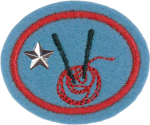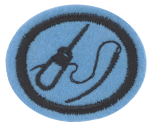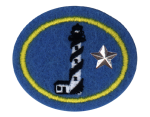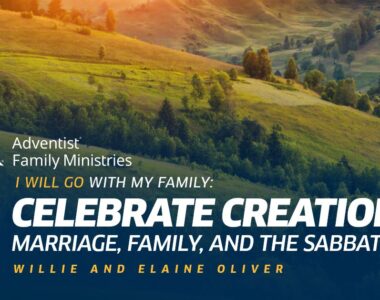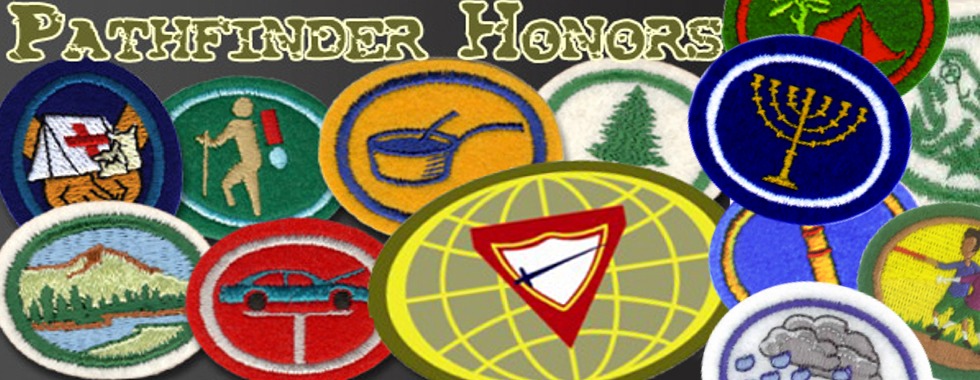
Felt Craft

- Skill Level: 1
- Original Honor: 1956
- Originating Institution: General Conference
Requirements:
- From what fiber is felt made? What gives it its tensile strength?
- List 15 uses of felt.
- Give three reasons why felt is a good material for handicrafts.
- List the essential steps in felt manufacture.
- Make two of the following, using at least two different colors of felt:
- a. Pennant
- b. Bookmark
- c. Refrigerator magnet
- d. Needle case
- e. Similar item
6. Make one of the following, using at least four different colors of felt:
- a. Small wall mural
- b. Holiday decoration
- c. Hand puppet
- d. Kitchen knick-knack
7. Make one of the following, using sewing:
- a. Stuffed animal
- b. Stuffed toy
- c. Tote bag
- d. Bean bag
Flower Arrangement
 Skill Level: 2
Skill Level: 2- Original Honor: 1938
- Originating Institution: General Conference
Requirements:
- Name six perennials and six annuals suitable for indoor flower arrangement.
- Name at least three flowers that bloom in the spring or early summer suitable for indoor flower arrangement.
- Name at least three flowers that do not keep well when cut, and three that do.
- Give six suggestions regarding the cutting of flowers and their aftercare, such as when to cut, how to cut, and how to keep.
- At what stage of development should roses, gladioluses, and dahlias be cut?
- Give three suggestions on the relation of containers to the flowers used, and three on the relation of arrangement to the room and furnishings.
- In flower arrangement, what should be the relation of dark and light shades, large and small flowers, open and partly open flowers?
- Make two artistic flower arrangements in each of the following areas: (Fresh or silk flowers may be used.)
- a. Table decoration
- b. General house use
- c. Public service
9. What are some wild flowers that could be used in arrangements for the home? What combinations of these flowers can be used?
Geneology & Advanced
- Category: Arts, Crafts, and Hobbies
- Skill Level 2
- Originating Organization: North American Division
Requirements:
1. Define the following words :
- a. genealogy
- b. ancestor
- c. descendant
- d. spouse
- e. sibling
2. Read the genealogy of Christ
- a. Be able to tell where it is found in the New Testament
- b. Write out the genealogy of Christ – beginning with Adam
3. List five ways to obtain family genealogy information
4. Know at least three societies that help with genealogy research
5. Learn four steps important to genealogy research
6. What is the purpose of documentation?
7. Define a primary source versus a secondary source for documentation.
8. Prepare a four-generation family chart – beginning with your self
9. List ways to record your genealogy information
10. Research your family history by talking/writing to your oldest living relative
Ask the following:
- a. first memory
- b. When and where you were born?
- c. First church you remember attending?
- d. Names of schools, and location, you attended
- e. Where you lived at age ten and age fourteen
- f. From what country did our ancestors emigrate?
- g. Where and when were you married
- h. If you had children please give their names, place and date of birth
- i. Write a thank you to your relative for their time and include a photo of yourself and ask them if they would be willing to share a copy of an older family photo with you.
11. Make a historical record of your life including:
- a. genealogical chart
- b. Records that pertain to your life
- c. Pictures
- d. Stories
- e. Share this with your group/club/school
12. Visit a City/County Library – Genealogy Section (or other Genealogy Research Center) and write a paragraph on your visit including:
- a. Types of information available
- b. Any New information you discovered about your family
13. Visit a cemetery and learn by copying the headstones:
- a. The names of three different families
- b. The dates of birth and death for these family members
- c. The average length of life for these family members
14. Check with your local cemetery officials to learn how upkeep is done and ask them how you can help with clean-up in a cemetery in your area. Then do it!
- Category: Arts, Crafts, and Hobbies
- Skill Level: 3
- Original Honor: 2006
- Originating Institution: North American Division
Advanced Requirements:
- Have the Genealogy Honor
- Define a primary source versus a secondary source for documentation.
- What is the purpose of documentation?
- Demonstrate a census extraction for one branch of your family from six of the following census: (for NAD find year of immigration and list the country from where they immigrated)
- a. 1840
- b. 1850
- c. 1860
- d. 1870
- e. 1880
- f. 1900
- g. 1910
- h. 1920
5. Show a pedigree chart you have filled out for 7 generations. List the information you have been unable to learn and what efforts you have made to locate this information.
6. Show 42 family group records you have filed out and the documentation notes to go with the family group record.
7. Find military records/pension records on one of your family members. If your family has none, then show military/pension records on any person.
8. Show vital records you have obtained for one person from item # 5 including:
- a. birth
- b. marriage
- c. death
9. Show a copy of 3 obituaries on relatives with documentation where you found them.
10. List four web sites/or libraries where you have been able to locate information for your family research.
11. Where in the Bible does it say not to spend time on fables and endless genealogies? What does the Seventh-day Adventist Commentary list as the reason
for this advice?
Gift Wrapping

- Skill Level: 1
- Original Honor: 2015
- Originating Institution: Euro-Asia Division
Requirements:
1. List five courtesy rules for giving and receiving gifts.
2. Do the following:
- a. Collect different types of wrapping paper, at least ten grades, five-by-seven centimeters in size.
- b. Choose a suitable gift wrap pattern for wrapping a gift to a child, an adult, a sister, a brother, etc.
- c. Demonstrate carefully wrapping a simple rectangular box in paper.
3. Wrap the following types of gifts with ornamental supplement:
- a. in the form of a cube
- b. in the form of a cylinder
- c. multifaceted
- d. extraordinary (your option).
4. Know how to make a gift bow (3 types).
5. Correctly and carefully pack a gift. Give the wrapped gift to someone in your family, church, or community
Glass Craft

- Original Honor: 1970
- Originating Institution: General Conference
Requirements:
- Name ten kinds of glass.
- Know what kind of glass is used for furniture, cloth insulation, airplanes, and automobiles.
- Prepare at least three colors of glass for picture making.
- Know the steps in making a picture with glass, and complete such a picture, using at least three colors.
- Write a 300-word report or give a three-minute oral report on the history of glass and how glass is made.
Glass Etching
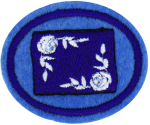
- Skill Level: 1
- riginal Honor: 1997
- Originating Institution: General Conference
Requirements:
- Name the tools and items needed for Glass Etching.
- Name the eleven steps of Glass Etching.
- What is the technique of applying velvet etch?
- Make a project on clear glass.
- a. Lettering or verses
- b. Flowers, animals, or people.
5. Make a project on a mirror. Include the following:
- a. Lettering, verses, flowers, animals, or people.
- b. Finish by framing around mirror with colored tape.
6. Make a project on a glass, jar, or oval object.
Glass Painting

- Skill Level: 1
- Original Honor: 1938
- Originating Institution: General Conference
Requirements:
- Know the primary colors, the secondary colors, and how to mix the primary colors to obtain the secondary colors.
- Know the materials used in painting, mounting, and hanging a glass painting.
- Make and display a glass painting for each of the following designs: animal, flower, and landscape or seascape.
- Make a silhouette painting and mount for hanging.
- Make a hand-painted mirror picture by removing the back coating of the mirror from the picture area and painting the design on the back of the mirror glass.
Guitar
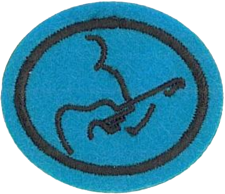
- Skill Level: 2
- riginal Honor: 2012
- Originating Institution: South America Division / North American Division
Requirements:
- Research the history of guitars and how they came to your country.
- Describe or show the difference between melody, harmony and rhythm.
- Distinguish three different types of guitars. Describe the advantages and disadvantages of each type.
- Identify the three divisions of the guitar and identify 15 different parts, explaining the function of each part.
- Demonstrate the correct posture to practice guitar. Explain the importance of practicing in that position.
- Know the names of the fingers, strings and hand positions. Demonstrate each in its proper way.
- In standard tuning, the 6 strings on a guitar are associated with which notes?
- What are the chords (figures) and how are they built? Write by memory a list of all major and minor chords, along with specific finger positions.
- Demonstrate ability to perform at least seven major and minor chords (ex. A, B, B7, C, D, E, G, F, A minor).
- Explain the difference between flats and sharps? Show how they are represented for guitar play.
- Describe the difference between nylon and steel stringing, and explain the reason behind your preference.
- Demonstrate the use of a capo and how to replace a guitar string.
- Play a song using at least two different techniques:
- Strumming
- Fingerpicking
- Classical
Other
Select three simple hymns or spiritual songs that you can play on guitar, and teach them to a unit, club or group.
Guitar, Advanced
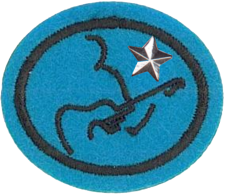
- Skill Level: 3
- Original Honor: 2012
- Originating Institution: South American and North American Divisions
Requirements:
- Have the Guitar honor.
- Define “Triads” and show how are they used. Demonstrate how to play triads derived from high score notes.
- Demonstrate two different methods of guitar tuning.
- Define tablature (tabs). Demonstrate how to read and perform tablature (tabs) on a guitar.
- Demonstrate how to change the key of a song to fit the vocal range of the singers.
- Define and explain the differences between consonant and dissonant chord?
- Practice and perform a solo in at least two scales with the guitar.
- Create a personal song book of at least 25 hymns and spiritual songs with chords properly written. Play them as part of a song service or performance during a club meeting worship service, worship, or other group function.
Kanzashi
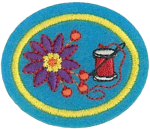
- Skill Level: 1
- Original Honor: 2015
- Originating Institution: Euro-Asia Division
Requirements
- Define Kanzashi, or Hana Kanzashi? Where did this art come from? How did it develop?
- Describe or show what materials and tools are used in Kanzashi?
- Show in what way the round three- or two-dimensional Kanzashi petals can be folded.
- Show in what way the narrow three- or two-dimensional Kanzashi petals can be folded.
- Show in what way the double round and double narrow Kanzashi petals can be folded.
- Make a Kanzashi flower with three-dimensional petals and fashion the back of fabric.
- Make a Kanzashi flower with two-dimensional petals and fashion the back of fabric.
- Make a finished Kanzashi product (hair-clip, brooch, etc).
Notes:
Kanzashi are woman’s hairpins, hairgrips, and combs, to be worn in hair, in combination with kimono. Kanzashi and kimono are often made in the same style.
The ornaments Hana Kanzashi (Kanzashi with flowers) are featured by silk flowers and threads containing small silk flowers that hang down about 20 cm. A Hana Kanzashi may be worth more than a kimono because making a Hana Kanzashi is a very meticulous work resembling jeweller’s work. Kanzashi are hair ornaments used in traditional Chinese and Japanese hairstyles. Kanzashi came into wide use during the Edo period, when artisans began to produce more finely crafted products. Nowadays, Kanzashi are most often worn by brides; by professional kimono wearers such as tayū and yujo; or by adepts in Japanese tea ceremony and ikebana. However, there is currently a revival among young Japanese women who wish to add an elegant touch to their business suit.[AdSense-B]
Knitting
 Skill Level: 2
Skill Level: 2- Original Honor: 1970
- Originating Institution: General Conference
Requirements:
1. Define the following:
- a. K
- b. P
- c. STS
- d. RND
- e. TOG
- f. PSSO
- g. INC
- h. DEC
- i. YO
2. Demonstrate the following:
- a. Cast on
- b. Bind off
- c. Cable stitch
- d. Ribbing
- e. Garter stitch
- f. Stockinette stitch
- g. Pick up a dropped stitch
3. Know how to care for these kinds of yarn:
- a. Wool
- b. Hair
- c. Synthetic
4. Show how to join on a new ball of yarn.
5. Identify and know the purpose of the following weights of yarn:
- a. Medium
- b. Sports
- c. Heavy
- d. Bulky
6. Knit two items from the following:
- a. Slippers
- b. Mittens
- c. Baby booties
- d. Hat
- e. Scarf
- f. Sleeveless sweater
- g. Reasonable choice
Knitting, Advanced

- Skill Level: 3
- Original Honor: 1970
- Originating Institution: General Conference
Requirements:
- Have the Knitting Honor.
- Knit a pair of argyle or patterned socks, gloves, or some other article, using four needles and yarn bobbins.
- Knit an afghan or a baby blanket.
- Knit a sweater with long sleeves or a baby set of sweater, bonnet, and booties.
Lapidary
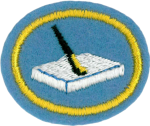
- Skill Level: 2
- Original Honor: 1967
- Originating Institution: North American Division
Requirements:
- Name four safety precautions to be taken when sawing rocks.
- Name two types of diamond saw lubricating and cooling solutions and their purpose.
- Explain how a diamond saw cuts rocks, how it gets dull, and how it can be sharp ened.
- Describe the five basic steps to follow in bringing a slab or a flat surface to a polish.
- What important precaution should be taken between each stage of grinding and sanding?
- What is a template, and how is it used?
- What is a cabochon, and what is the usual thickness of the slab from which it is made?
- How do you decide the best angle or position to slab a specimen?
- Explain two methods of wet sanding while shaping and polishing the rock.
- From what material are polishing compounds made? If a scratch appears while polishing, how is it removed?
- Saw, trim, properly dop, and carry a cabochon through the necessary grinding, sanding, and polishing stages to a high gloss or glassy finish.
- Mount the cabochon on some type of backing, such as a stick pin, sweater pin, key ring, etc., with cement.
Leather Craft

- Skill Level: 1
- Original Honor: 1937
- Originating Institution: General Conference
Requirements:
- List the necessary tools a beginner needs in leather craft and demonstrate the proper use of each.
- Know how to distinguish different kinds of leather, such as calf, goat, and imitation leather. What leathers are most suitable for tooling?
- Give the steps necessary in the preparation of leather.
- Transfer a design to leather, and tool and lace some object in leather, such as a billfold, magazine cover, belt, key keeper, or small purse.
- Show how to use leather dye.
- What kind of finish should be used on leather?
Leather Craft, Advanced
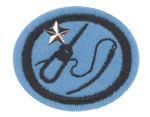
- Skill Level: 2
- Original Honor: 1977
- Originating Institution: General Conference
Requirements:
- Have the Leather Craft Honor.
- Show how to punch holes, set snaps, do saddle stitching, and do two types of lacing.
- Make a sheath for a hatchet, knife, or ax.
- Complete a figure-carved belt, doing your own tooling.
- From your own design, cut from leather, tool, punch, and lace a project such as a case, purse, bag, or an equivalent.
- Show six leather items you have made.
LEGO Design
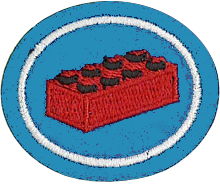
- Skill Level: 1
- Originating Institution: North American Division
Requirements:
1. Know the following terms:
- A. Element
- B. Stud
- C. Brick
- D. Plate
- E. Base Plate
- F. Tile
- G. Slope
- H. Inverted Slope
- I. Hinge
- J. Technics Brick
- K. Power Functions
- L. Mini-figure
2. Build and/or find examples of following types of scale models:
- A. Micro Scale (1 city block equals 32 studs)
- B. Mini-figure Scale (6 feet or 2 meters, equals roughly 6 studs)
- C. Ultimate Collector Scale (larger than Mini-figure Scale and smaller than 1 tot 1 scale)
- D. 1 to 1 Scale (Actual Size)
3. Choose one of the following:
- A. Build a 1 to 1 scale model of something from nature, your home, church, or school. Then share your model with your group or club.
- B. Build a scale model of your house, apartment, or other building in your community. Be sure to include large furniture items like bed, stove, refrigerator, sofa, & dresser, etc. Then share your model with your group or club.
4. Choose one of the following:
- A. Use LEGO® as visual aid in a Children’s Story for youth ages 2-9 at church or Sabbath School.
- B. Use LEGO® as part of a school project.
5. Build a scene or an item from the Bible using LEGO® in one of the scale sizes from Requirement #2.
6. From your imagination create your own design in 2 of the 5 categories below and share both designs with your group or club.
- A. Car, truck, or other land vehicle.
- B. Plane, helicopter, or other aircraft.
- C. Ship, submarine, or other watercraft.
- D. Brick built animal or plant based on a real species using at least 10 pieces.
- E. Machine, appliance, or robot (without power functions)
7. Write a 250 word paragraph, or in a 3-5 minute presentation to you group or club, tell how you can use LEGO® to witness to those that don’t know about God.
LEGO, the LEGO logo and the minifigure are trademarks and/or copyrights of The LEGO Group. Pathfinders and the Seventh-Day Adventist Church are not affiliated with and/or facilitated by The LEGO Group.
Lettering & Poster Making
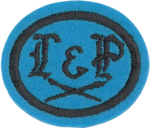
- Skill Level: 2
- Original Honor: 1933
- Originating Institution: General Conference
Requirements:
- Write from memory the complete lower case alphabet in two of the following: Gothic, Roman, or Italic.
- Demonstrate when the different sizes and types of pens are to be used.
- State at least four principles in making a poster attractive and distinctive. Know how to make correct margins for the size of paper you are using.
- Make three posters in a variety of sizes to be used by any of the following groups: Sabbath School, church, school, Pathfinder Club, or AY Society. Use at least two different types of lettering in these posters.
- Make five additional posters on topics of your own choice. These posters will be judged for acceptance on the following three conditions:
- a. Arrangement
- b. Neatness
- c. Selection in type of lettering used.
6. Practice all strokes until they can be done smoothly and accurately.
Lighthouses
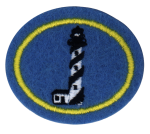
- Skill Level: 1
- Original Honor: 2007
- Originating Institution: North American Division
Requirements:
1. Describe the following in detail concerning lighthouses:
- a. What is the function of a lighthouse?
- b. When were the first lighthouses of record built?
- c. What is the name of the most famous ancient lighthouse?
- d. What are people called who study lighthouses? Why?
- e. Do all lighthouses have keepers? If not, how are they run?
2. Research the structure and function of Fresnel lenses. Explain what makes these lenses so effective.
3. Throughout history, what fuels were used for lighthouse lights?
4. Are all lighthouses located along ocean shores? If not, list other locations where you would find a lighthouse.
5. What is the lighthouse service called in your country? What organization or branch of government is responsible for maintaining lighthouses in your country?
6. When a lighthouse is a visible landmark seen from the ocean during the day it can be identified by certain markings. What are these called?
7. What is a foghorn? Why would one be used at a lighthouse? What are three things that affect how far away a foghorn can be heard?
8. Since lighthouses are often called “lights”, explore the concept of “lights” in scripture by doing the following:
- a. Look in the Bible Concordance to find “lights” and discuss lights as referred to in the Bible
- b. Explain why you think God’s word is like a lighthouse.
- c. Memorize John 8:12.
9. Write a poem or a story about a lighthouse light. Include thoughts of God’s “light”. Read your story or poem to your group.
10. Draw or photograph five lighthouse forms/types being used today.
11. Do one of the following:
- a. List the names and locations of 5 lighthouses in your state/province.
- b. Locate on a map the location of 10 lighthouses in your country/division
12. List the references you used to learn about lighthouses.
Lighthouses, Advanced
- Skill Level: 3
- Original Honor: 2007
- Originating Institution: North American Division
Requirements:
1. Have the Lighthouses Honor
2. Make a scrapbook including the following:
- a. Pictures, post cards or drawings of twenty-five lighthouses. Label should include a brief description of: location, year built, active/non-active status, and order of the lens.
- b. Write up a short history of the above lighthouses.
- c. Include drawings/pictures and answers to all the requirements for this honor in your scrapbook.
3. List the development of a Fresnel lens, including:
- a. Name of the gentleman that invented it.
- b. Country that he came from
- c. Year developed
4. Draw a Fresnel lens:
- a. Show how prisms are used to concentrate light
- b. Draw a bull’s eye lens and state its purpose
5. Make a chart showing each class of Fresnel lens:
- a. Define order and list by size
- b. Name at least one lighthouse using each order
6. Research and describe the history of the mechanism for rotating lights
7. Make a chart of six lighthouses showing nighttime (light) and daytime (day mark) signature.
8. What is a lightship? Why and where are lightships needed?
9. Read about lighthouse keepers and list some of the hazards they faced in completing their duties.
10. Study quotes by Ellen White mentioning lighthouses and discuss the meaning. Place a copy of the quotes in your scrapbook.
11. Obtain a “Lighthouse Passport” and have it stamped at 10 different lighthouse locations.
12. Build a lighthouse modeled after a real lighthouse using a lighthouse kit, wood, or other medium. Know the name, location, and date when the actual lighthouse was originally built.

 Skill Level: 2
Skill Level: 2 Skill Level: 2
Skill Level: 2